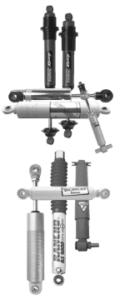Tech Articles
Shock Therapy – Choosing the Right Shock Absorbers
- By Jim Kaekel, Jr.
Choosing the right shock absorbers for a vehicle can make a dramatic difference in its handling on the street, off-road, or on the track.
Most performance enthusiasts raise the hood of their high-octane toy at least once a week, trying to find that last little bit of performance that they can squeeze out of the engine. However, we wonder when they last got out the jack and took a close look underneath the car, specifically, at the shock absorbers.
Countless race and performance cars make plenty of power, but when it comes down to the wire, they can’t hold up because they lack a decent suspension set-up, of which shock absorbers are a key element. While today’s bolt-on suspension systems can provide older muscle cars and even trucks with the benefits of modern suspension components, choosing the right shock absorbers is critical for optimal handling and performance.
The sole purpose of a shock absorber is to control the velocity of the suspension movement by creating resistance to the vertical movement of the wheel, or DAMPENING.
The extension cycle of a shock absorber consists of a COMPRESSION stage and a REBOUND stage. Dampening occurs throughout the entire extension cycle, regardless of whether the shock is on a pick-up truck running down a bumpy country road, a nine-second drag car, or a thoroughbred circle track car heading into a banked corner.
A shock’s dampening rate is determined by how quickly the piston in the shock moves as it reacts to an uneven spot on the driving surface. The faster the piston moves, the firmer it becomes during both compression and rebound, as a result of the resistance it encounters as the piston travels through the oil reservoir inside the shock absorber body. For some shock absorbers, the dampening rate is fixed at the factory. Other shocks offer adjustable valving, allowing adjustment of the dampening rate to better fit the vehicle or driving surface.
Selecting a shock absorber for a high-performance application is just as important as selecting any other component on the vehicle. It is a very specialized process, and we strongly suggest seeking advice from qualified professionals.
Shock absorbers designed for particular applications like racing have specific dampening rates to optimize their performance under the conditions common to that racing discipline.
If the dampening is too TIGHT, the tires will not be able to maintain proper contact with the race track surface, resulting in an OVERDAMPENED shock condition. If the shock dampening is too LOOSE, the suspension will move too quickly, likewise causing the tires to lose contact.
The appropriate shock absorber for any driving application will achieve CRITICAL DAMPENING (a perfect balance), and will provide just enough control without any suspension cycling. The easiest way to achieve this critical dampening is with single or double-adjustable shock absorbers.
With all adjustable shock absorbers, a simple turn of a knob can change the dampening. On SINGLE adjustable shocks, the rebound setting can be adjusted, but the compression setting remains fixed. DOUBLE adjustable shock absorbers, very popular with racers, are built with unique valving that allows both the rebound and compression to be adjusted. Koni even offers a double adjustable shock absorber for drag racers that features a remote control for down track rebound adjustment allowing maximum traction throughout the run.

With many high-quality brands and a wide selection of shock absorber styles, it’s possible to find the right fit for virtually any vehicle and racing application. Most shock absorber manufacturers’ catalogs contain helpful charts that provide guidance on the ideal shocks for a particular application. These companies also maintain excellent tech support via phone and web.
Whether drag racer, dirt or asphalt oval track racer, off-roader, street machine, or street rod enthusiast, the proper shock absorber will not only provide better handling, but improved traction as well. It’s worth the investment of time and money to give that “pride and joy” vehicle a little shock therapy!